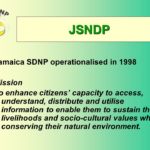Governments in developing countries are just one of the many players involved in promoting sustainable development – in many cases, with direct support from bilateral and multilateral donor organizations.  However, governments are, in principle, bound by the overall development commitments they make at the national and international levels.
However, governments are, in principle, bound by the overall development commitments they make at the national and international levels.
There are indeed several different interconnected layers here that constitute what can be called the development onion.
At the international level, most governments in the Global South have committed to the SDG agenda and should achieve the many targets set by 2030. This is the outer layer of the onion. However, international cooperation is not limited to the SDGs. Global themes such as cybersecurity, terrorism, refugees and other humanitarian issues also draw the attention of developing country governments among different stakeholders. That adds to the list of priorities while local capacities remain constant in the short-run.
The second layer is comprised of national-level development agendas. Unlike the SDGs, they tend to be short-term and frequently change in sync with national electoral processes. Regardless of political regimes, it is rare to find a developing country lacking a national development strategy or plan. While framed within the internationally agreed development goals, many national agendas prioritize core themes and might even introduce new ones in response to specific local contexts.
The third layer emerges at the provincial level. States within a given country also generate their development agendas that should, in principle, use both international and national strategies as reference. Most end up reframing goals and targets according to regional needs and gaps.
Finally, the city level opens the way for a plethora of local agendas ranging from large urban centers to small-to-medium size towns. These strategies capture the unique development idiosyncrasies of such geographies. However, they must also successfully navigate the various agendas already set in the three top layers. At any rate, the fourth layer of the onion is a door to many other sublayers, given the diverse character of cities and towns (including rural areas) around the globe.
Syncing up all these levels is not always straightforward, nor does it always take place in practice. Finding seemingly dissimilar development agendas within one single country is thus not the exception.
Nevertheless, one critical trait of the development onion is the fact that the smaller their geographical range, the sharper their scope is as they end up highlighting pressing on the ground priorities that many local stakeholders can easily recognize and identify with. The SDG agenda, which claims to be universal, is much more generic and thus need to be localized. In theory, this is precisely the role the onion sublayers described above should accomplish.
All in all, these multiple development layers offer critical entry points to donors, development practitioners, and technologists promoting development. In this light, the issue of technologies desperately seeking problems to solve should be a no-brainer. On the contrary, Problems abound and are urgently looking for solutions – although technology might not be the answer to many of them,
Paradoxically, while a plethora of entry points exist at different national levels in developing countries, many digital technology innovators and promoters tend to ignore them. Instead, the opt for developing so-called use cases that could entirely miss the mark by a long shot – as they are supply-driven and usually ignore complex local conditions.
However, external actors can also find entry points not linked to any particular development strategy and thus rapidly deploy new technologies on the ground, mainly if the funding required is minimal or provided by a foreign donor. For the most part, these efforts are not sustainable in the medium-term as ownership by local actors and institutions is absent.
Once the funding is over, these initiatives tend to fizzle into oblivion. Destructive creation at work here.
Cheers, Raúl






